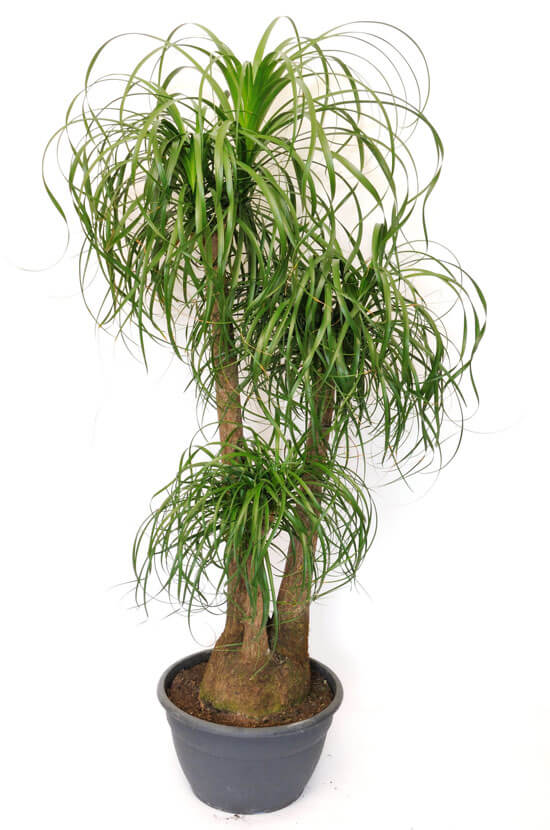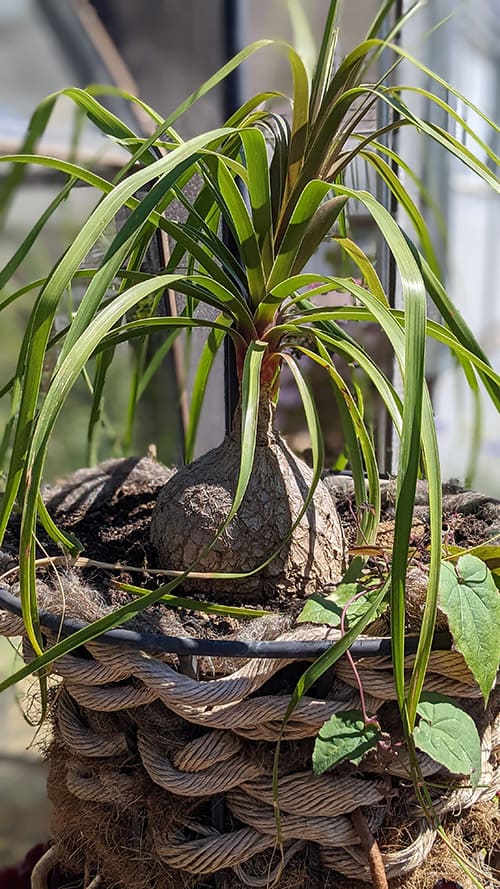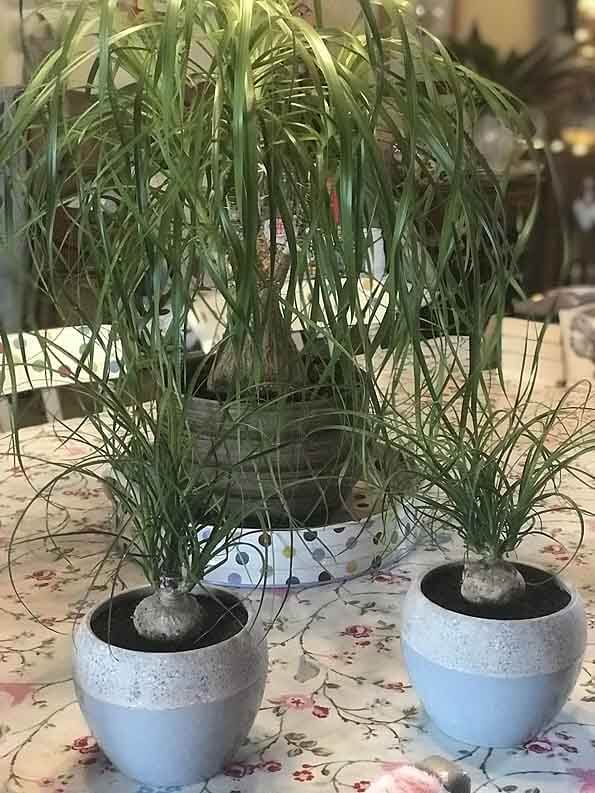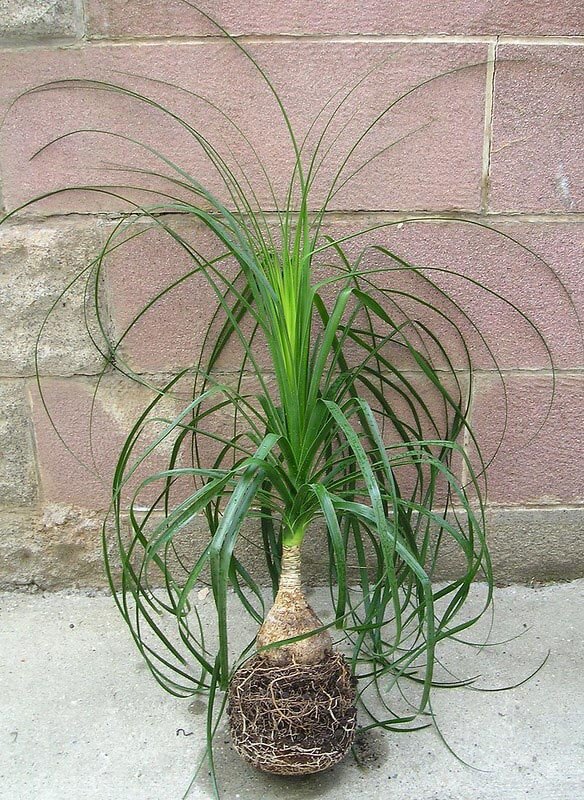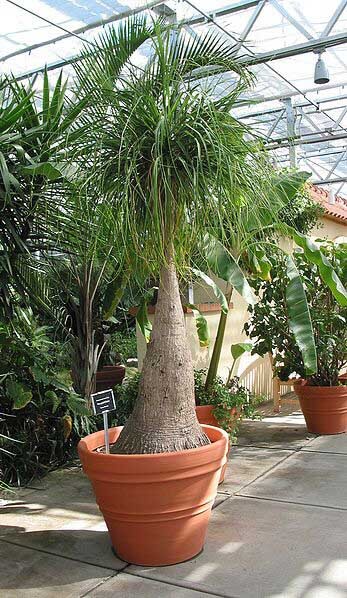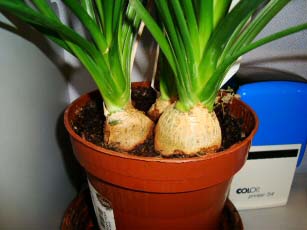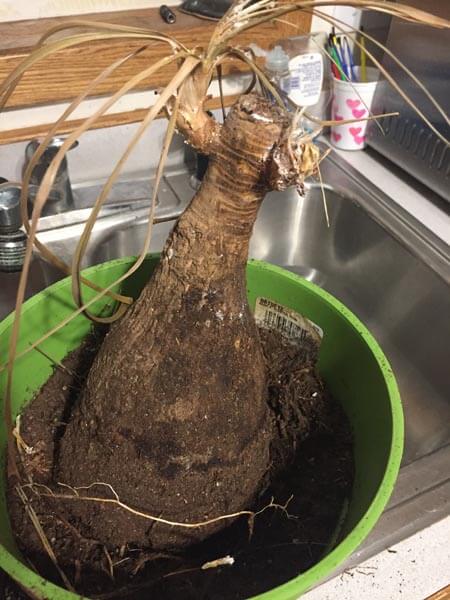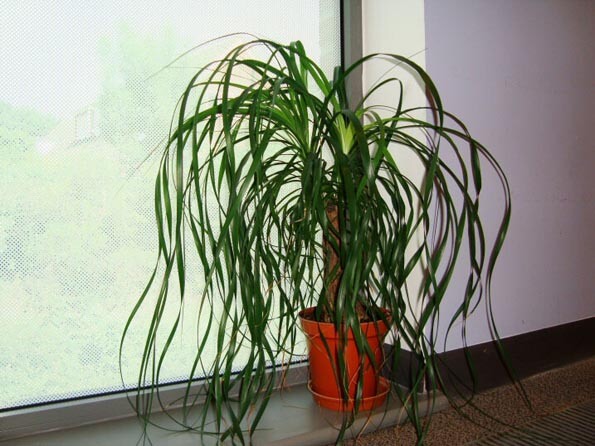The Ponytail Palm, also known as Beaucarnea Recurvata, or Nolina is a distinctive looking popular houseplant with a swollen thick brown stem at its base that stores water. The long narrow curly, dark green leaves flow up from this base much like a plume of water in a fountain.
Dr. Hessayon describes this houseplant as "A curiosity rather than a thing of beauty" however we are more inclined to say it's both.
A multi-stemmed Ponytail Palm showing off the brown trunk and curly leaves - Photo by Mike Atkinson
Very young, and small plants look like large rocks sprouting leaves, but as it ages the plant gradually becomes significantly taller. This more mature look has an appearance which in our opinion better resembles a miniature Willow tree. Elegant, curious and beautiful.
Did you know
Another popular common name for this plant is Elephant Foot Tree because of the swollen lower trunk looking like the foot of an Elephant.
It hails natively from the dry regions of Mexico and is a member of the agave family. In common with other plants in this family, it has the ability to hold water in the bulbous trunk, which is an adaptation of coming from such an arid place.
Although it's able to survive with little water and care, it does best if watered frequently and as the plant is very slow-growing anyway it's a good idea not to treat it poorly if you can help it.
These are super tactile plants and the leaves just invite you to run your fingers through them. The good news is that they'll put up with a bit of affection like this from time to time and they're not toxic to people or animals.
That said, all of this plant can look like a fun play toy for your cat. The brown stem resembles a scratching post and the ribbon-like leaves can be irresistible for playful cats. Keep your Ponytail Palm away from your pets for your plant's health and good looks.
How do you pronounce Beaucarnea Recurvata correctly? Say:
boe-KAR-nee-uh reck-er-VAY-tuh
These are very slow-growing houseplants which tend to make them more expensive than other plants of a similar size. Small young plants will be reasonably priced, but more impressive looking plants will be significantly more. They make a good statement plant and can live for decades if treated properly so it can be a good investment.
The Ponytail Palm is so well adapted to storing water, you may find it listed as either a succulent or a foliage plant. In temperate regions of the world, it may be sold as a garden rather than an indoor plant.
Although two plants can grow differently and end up looking quite different in respect of the shape and size of the swollen thick brown stem, it has no significant varieties or cultivars to pick from. Only buy plants called Beaucarnea Recurvata, or Nolina "Recurvata".
If you gradually accustom your Ponytail Palm plant to direct sunlight, you can grow it outside during the warmer months of the year. We explain how in the care instructions next.

Hi, I'm Tom!
If you're like me and enjoy the challenge of growing houseplants and getting them to thrive, then Ourhouseplants can help. This website shares my knowledge and years of growing plants and provides (hopefully) helpful advice on properly caring for your indoor plant friends.
These plants will grow slowly at the best of times and although the plant will do okay in a slightly shady spot, it does need bright light for it to thrive. If you can provide some sun, within a few weeks you'll see the plant converting this into lush new visible leaves, i.e. more light equals more growth.
Plants grown in shade should not suddenly be moved and plonked into a very sunny spot. Move your plant to this new location for a few hours a day and then back again. Do this for a week so it gets used to the change in light intensity. This will prevent the leaves from burning and becoming disfigured.
At the base of the Ponytail Palm is a thick swollen stem that has a woody appearance. This is a water storage organ, which is capable of supporting the plant in times of drought. This should indicate to you that the plant expects longish periods between watering. A great houseplant for those people looking for easy going and low maintenance.
Tip
If you're growing yours in a very small pot with only a little bit of soil, it will dry out quicker and might need more frequent watering.
Ideally, you should aim to water at least a few times a month (once a week in the height of Summer if possible) and when you do so, make sure it's a thorough watering.
The water reserves will support the plant if you forget to water it from time to time, but don't make this into a habit or you will get a surviving rather than thriving plant.
Keep it away from super dry areas, like that found around a working radiator. The leaf edges and tips of your plant will brown if the humidity is very low, but otherwise humidity isn't overly important.
A general all-purpose fertiliser will be fine. These aren't overly hungry plants and so a light feed once every month in Spring and Summer will be enough.
One of our readers, Lynda, has had the larger palm in this photo for over 10 years. The smaller plants are new additions to the family
When it comes to temperature requirements unlike most houseplants the Ponytail Palm is close to being hardy and will accept almost sub-zero temperatures. Exposing your plant to such a low temperature however would surely be by accident and not a regular occurrence right? *wink*.
To be safe, try not to ever go lower than 7°C (45°F) and although higher temperatures will be accepted, you should get good levels of growth at around 21°C (70°F).
If growing well you could be repotting once a year. If conditions are not so good or you want to restrict the size of the plant, only repot every 2 or 3 years.
Providing you're feeding once a month or so, these houseplants still do well in small pots and although they have a huge amount going on above the surface, the roots can be fairly compact as shown in the photo below.
When the time comes to repot, no special soil or tips need to be followed. Standard everyday potting soil is fine, just make sure it's fresh and not old or used. You can also use succulent soil or a potting mix which will aid in drainage. It's not essential to use this, but if you're a known over-waterer it could be a good investment.
From an appearance and cosmetic point of view, you might want to try and go for a tall container to help keep the long leaves from dragging along the ground.
Although they can be tall plants, they only have small root balls - Photo by Maja Dumat
Propagating a Ponytail Palm is pretty difficult because it's done typically through the offsets it periodically produces. The difficultly is that the offsets depend on the parent plant and don't establish their roots very quickly. This means if you separate an offset too early then it will rely on you to get things spot on.
None of the Our House Plants.com team have propagated a Ponytail Palm, but if you give it a try you might like to use a rooting hormone to increase your chances. Conditions should then be provided as above.
Expect very slow or non-existent growth if light levels are poor or you don't follow the step by step care tips above.
When the conditions are favorable you can look forward to... Slow growth!
The simple truth about these plants is that they grow slowly even if given all the right conditions. Great if you don't want it to outgrow the spot for a while, but not so good if you want it to become a tall and majestic plant quickly.
Most Ponytail Palms in the home will never reach this height, but out in their natural habitats, they can almost touch the sky at a whopping 15 feet / 4.5 meters. Indoors they will grow tall, but this takes a long time (see the point above).
A mature Beaucarnea Recurvata taken by Roger Williams
Yes, this houseplant does have flowers! But very rarely indoors and even if you do get them, they're unremarkable.
No, the Ponytail Palm is not toxic to dogs, cats or people. Although you should keep it away from pets as they can be mistaken for toys and damaged by sharp claws or curious teeth.
When you come to buy your plant it's common to find either a planter with one mature plant or a smaller container with a cluster of typically three small plants in it. The smaller planter is a quick and clever fix if you want an instant flush of leaves without having to wait several years for them to grow longer. Leave them growing like that, or separate them if you prefer.
Three Small Ponytail palms in a brown planter.
Medium to Bright Light Good light with some sun is preferred. Avoid shady and low light spots.
Low to Moderate Watering Water well and then don't water again until the potting mix has dried out almost completely.
Temperature Warm rooms of around 21°C (70°F) are needed or the plant won't grow.
Feeding Once a month (or less) using a liquid fertiliser.
Crispy brown tips on the ends of the leaves
This tends to happen with both age and also if the humidity is very low. Once brown, the green isn't coming back so cut the tips off. Try to find ways to increase humidity to prevent this from happening in the future.
My Ponytail Palm was overwatered. The neck has gone soft.
Although it's a forgiving plant for the most part, this is the result of an overwatered and pest infestation on a Ponytail Palm houseplant.
Yikes! The lack of green leaves makes me think that plant is dead, to be honest. There seems to be a few things going on here:
Mealybugs
Mealybugs are another sap-sucking insect pest. They look somewhat like woodlice covered in white cotton wool. The removal is the same as for Scale insects detailed below, (although you may be able to do without the methylated spirit and use water if you prefer not to use harsh chemicals. You can also use Neem Oil).
Scale insects
Scale is an annoying insect that sucks sap from the leaves disrupting normal plant function and growth. Look for small brown discs scatted over the leaves, you need to remove these to eliminate the insects (and the eggs) underneath them.
To do this use a cotton wool bud soaked in methylated spirit, and rub over the discs, this will dissolve the scale and allow it to be removed from the leaves. You can also try and use a commercial type spray, although it might not be as effective because Scale Insects tightly adhere to the leaf surface making penetration of the outer shell difficult.
Ponytail Palm isn't growing
As long as you haven't confused no growth with slow growth, check for Scale, Mealybugs and another pest that might be lurking. Make sure it's in a bright spot, the temperature is warm and you're watering fairly often. All of these are essential to getting the plant to grow.
If all these conditions have already been met and still no active growth after a few months, consider repotting or as a last resort increasing your feeding routine (don't increase the dosage, just do it more frequently).
I think it's more common to stumble across this plant in a store than search one out. They're just not overly popular or trendy houseplants at the moment. But when you do see it, it's hard not to be drawn to it's quirky and unusual look. It just stands out and attracts you.
This is what happened to me about 10 years ago, a very small Ponytail Palm, growing in a decorative pot. Looking like a lump of light brown wood with sprouting curly green hair! I had to have it, so the curious little plant came home with me and settled in.
10 years later and it's bigger but not huge (which is what I would like it to be). Although it's proven to be super simple and easy to care for, it's painfully slow-growing.
Mature Ponytail Palm with a tall stem and very long leaves
I'm not the most patient person and after a few years of it hardly growing I decided to ship it out to my work office. This is where I normally take my, less loved plants shall we say.
I can still admire them and look after them and still get all the benefits houseplants can offer but not lose valuable "plant space" at home which I reserve for more entertaining plants.
However, I'll reiterate that the Ponytail Palm is a super easy houseplant and hard to get it wrong. Follow the care guide instructions above and pick a good looking plant from a store instead of a small one and hoping it will grow into something beautiful quickly, and you won't go far wrong!
